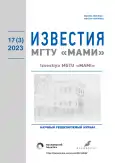Evaluation of the technical and economic efficiency of controlled power distribution in transmissions of all-wheel drive trucks
- Authors: Keller A.V.1,2, Popov A.V.3, Okolnishnikova I.Y.4
-
Affiliations:
- Sociological Research Center
- Moscow Polytechnic University
- Central Scientific and Research Institute of Automobiles and Automotive Engines “NAMI”
- State University of Management
- Issue: Vol 17, No 3 (2023)
- Pages: 251-260
- Section: Transport and transport-technological facilities
- URL: https://journals.rcsi.science/2074-0530/article/view/249926
- DOI: https://doi.org/10.17816/2074-0530-568179
- ID: 249926
Cite item
Full Text
Abstract
BACKGROUD: Operating conditions of all-wheel drive trucks determine the probability of motion in conditions of uneven distribution of grip and rolling resistance for driven wheels of various axles and sides, which actualizes torque redistribution from an engine to the driven wheels. Reasonable power distribution between driven axles and wheels is important in order to improve the efficiency of all-wheel drive vehicles.
AIMS: Evaluation of technical and economic efficiency of controlled power distribution in transmissions of all-wheel drive trucks with hydraulically controlled friction clutches.
METHODS: A series of experiments was carried out on the basis of the KAMAZ-65222 with a differential lock control system with hydraulically driven friction clutches and a measuring and recording facility. The technical efficiency of control on differentials when driving in various road conditions was evaluated by the acceleration duration of the vehicle, the average speed of straight-line movement and when performing a maneuver, the parameters of the ground clearance, fuel efficiency and comparative loading of the wheels drive.
RESULTS: The experiment confirmed the effectiveness of the algorithm for automatic control of the differential lock in the vehicle transmission in terms of cross-country abilities, workload and fuel efficiency. An increase up to 16.7% of the average speed in difficult road conditions, a decrease of the specific work of rolling resistance overcoming and a decrease in fuel consumption by 7–8% were recorded.
CONCLUSION: Evaluation of efficiency of solutions for control on differentials in transmission of an all-wheel drive truck showed a significant increase in dynamic properties, cross-country abilities and fuel efficiency. Automatic change of the lock degree of differentials in the transmission when driving on a curved path and on uneven surface has a positive effect on transmission reliability and fuel efficiency, ensuring stability and maneuverability to remain stable. The expected economic effect is more than 206.3 thousand rubles. per year for one vehicle.
Full Text
##article.viewOnOriginalSite##About the authors
Andrey V. Keller
Sociological Research Center; Moscow Polytechnic University
Author for correspondence.
Email: andreikeller@rambler.ru
ORCID iD: 0000-0003-4183-9489
SPIN-code: 4622-5727
Professor, Dr. Sci. (Tech), Head of the Land Vehicles Department, Acting Director
Russian Federation, Moscow; MoscowAndrey V. Popov
Central Scientific and Research Institute of Automobiles and Automotive Engines “NAMI”
Email: popov.andrey@gmail.com
ORCID iD: 0009-0006-3266-9464
Postgraduate of the Scientific and Educational Center
Russian Federation, MoscowIrina Y. Okolnishnikova
State University of Management
Email: okolnishnikova.i@mail.ru
ORCID iD: 0000-0002-4958-8189
SPIN-code: 6286-0401
Professor, Dr. Sci. (Economics), Head of the Service Marketing and Brand Management Department
Russian Federation, MoscowReferences
- Transport in Russia. 2022: Stat. collection. Moscow: Rosstat; 2022. (in Russ). Accessed: 17.07.2023. Available from: https://rosstat.gov.ru/storage/mediabank/Transport_2022.pdf
- Density of paved roads in Russia by region. Mirkart [internet] Accessed: 17.07.2023. Available from: https://миркарт.рф/%D0%BA%D0%B0%D1%8=126
- How many all-wheel drive trucks are there in Russia? Marketing agency NAPI. [internet] Accessed: 17.07.2023. Available from: https://napinfo.ru/infographics/skolko-v-rossii-polnoprivodnykh-gruzovikov/
- Zagarin DA, Kozlovskaya MA, Dzotsenidze TD. Analysis of the need and demand for agricultural machinery in conditions of a structural crisis in the economy. Avtomobilnaya promyshlennost. 2020;9:1–7. (in Russ).
- Deryuzhenko SA, Ushnurtsev SV. Automation of traffic control of military tracked and wheeled vehicles. Omsk: Omskiy avtobronetankovyy inzhenernyy institut; 2023. (in Russ).
- Kotiev GO, Dyakov AS, Sologub SA. On the need to create production of special wheeled and tracked vehicles for operation in the Arctic zone of the Russian Federation. Zhurnal avtomobilnykh inzhenerov. 2018;4(111):27–29. (in Russ).
- Kotlyarenko VI. Historical overview of the main directions for increasing the cross-country ability of traditional wheeled vehicles. Trudy NAMI. 2022;3(290):45–62. (in Russ). doi: 10.51187/0135-3152-2022-3-45-62
- Pirkovsky YuV, Shukhman SB. Theory of motion of an all-wheel drive vehicle (applied issues of optimization of chassis design). Moscow: YuNITI-DANA; 2001. (in Russ).
- Leshchinsky DYu, Smirnov AA, Yagubova EV. Analysis of promising designs of vehicle drive axles using the example of patents from global manufacturers. Inzhenernyy zhurnal: nauka i innovatsii. 2013;12(24):24. (in Russ).
- Keller A, Aliukov S. Effectiveness of Methods of Power Distribution in Transmissions of All-Wheel-Drive Trucks. SAE Technical Papers. 2015;2015-September. doi: 10.4271/2015-01-2732
- Dygalo V, Keller A, Shcherbin A. Principles of application of virtual and physical simulation technology in production of digital twin of active vehicle safety systems. In: Transportation Research Procedia : 14, Saint Petersburg, 21–24/10/2020. Saint Petersburg; 2020:121–129. doi: 10.1016/j.trpro.2020.10.015
- Belousov BN, Popov SD. Wheeled vehicles with particularly large load-carrying capacity. Design. Theory. Calculation. Moscow: MGTU im NE Baumana; 2006. (in Russ).
- Chistov MP, Kovalev VV. Army road trains and road conditions. Avtomobilnaya promyshlennost. 2001. № 11. С. 18–20. (in Russ).
- Larin VV. Metody prognozirovaniya i povysheniya opornoy prokhodimosti mnogoosnykh kolesnykh mashin na mestnosti [dissertation] Moscow; 2007. (in Russ).
- RTM 37.001.053-2000 Voennaya avtomobilnaya tekhnika. Metody opredeleniya pokazateley prokhodimosti avtomobiley. (in Russ).
Supplementary files









